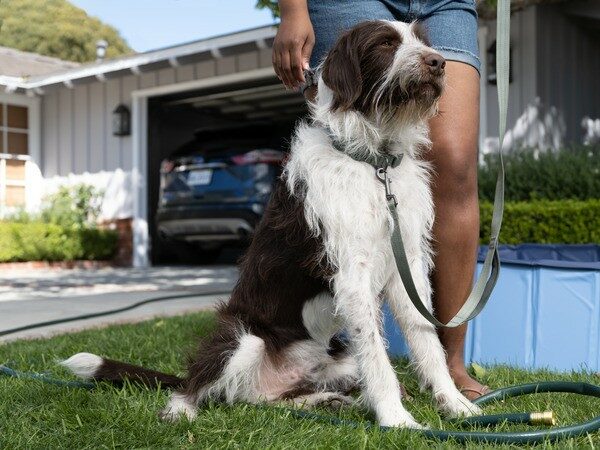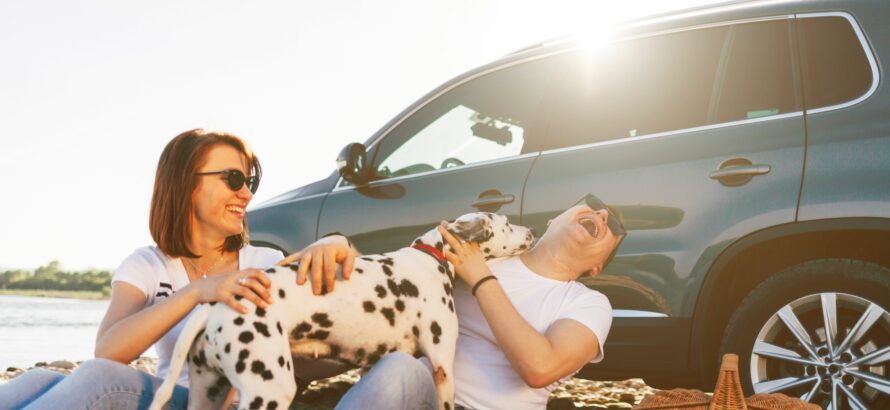
Do you know how to keep your pet safe when the weather heats up? Like most people, you’re likely careful to never leave pets in vehicles when it’s hot outside. But there’s more to know when it comes to keeping pets cool, comfortable, and out of danger. From vet visits to insurance coverage, it’s smart to plan ahead so your 4-legged friend can put their best paw forward.
Dogs are generally at highest risk for overheating. When it’s hot, cats prefer to chill. Your dog, on the other hand, will try to go for a run or play fetch no matter the temperature. That means you must avoid hazardous situations and know what to do if your pet overheats. Read on to find out how to prevent pet overheating, common symptoms and how you can cool a pet down.
3 ways to prevent dogs and cats from overheating
1. Keep the most at-risk pets inside and keep the air conditioning on for them
Older pets as well as kittens or puppies don’t handle weather extremes as well as healthy adult pets. In addition, dogs or cats of breeds known as “brachycephalic” – short-nosed pets such as bulldogs, pugs or Persian cats – have a greater difficulty keeping themselves from overheating. These high-risk pets should be kept inside where it’s cool, and any outings should be short – potty runs only.
2. Exercise your dog during cooler parts of the day
While short-nosed pets should be kept inside where it’s cool, other pets can enjoy supervised outdoor time early in the morning or late in the day. Walks are good for both dogs and people, and you don’t have to skip them, just time them better. One rule of thumb: Put your hand on the sidewalk, and if it’s too hot to leave it there, it’s too hot for your pet’s paws.
3. Always have enough water
Whatever your summer activities, make sure there’s plenty of cool, fresh water available for your pets. When you’re out and about, take water with you and don’t let pets drink from pools, standing water or oceans. There are handy devices you can buy from pet product retailers to make it easy to bring water along. Products that have flip-down cups or nozzles mean you don’t have to carry a bowl with you.
How to tell if your pet is overheating
Just as important as keeping pets out of heat danger is knowing what to do if a pet overheats.
Dog overheating symptoms
The signs in dogs – the most likely victims — are rapid, even frantic panting, very red gums, and a glassy look in their eyes.
Cat overheating symptoms
Cats will have similar overheating symptoms as dogs, including panting, rapid heartbeat, dark red gums, hyperventilation and restlessness as the cat tries to find a cooler spot.
How to cool down an overheating pet
An overheated dog or cat is in a life-threatening situation. Apply cool water- not icy cold, and not ice – to the groin area and get your pet to your veterinarian or an emergency veterinary hospital right away.
Other pet summer safety tips
Overheating is not the only issue pets face in the summer. Read on to learn more health tips for your pet.
Get your pet in tip top shape
Help keep your pet in the trim by feeding them well-proportioned, nutritious meals, along with healthy snacks. Ask your vet for recommendations. Make sure their weight is in the range for their breed and age, otherwise they may have serious health problems down the road. The main cause of obesity in pets is overfeeding, so don’t fall victim to those puppy eyes (we know it’s hard).
Protect your pal’s skin
Think all that fur shields your pet from harmful ultraviolet rays? With skin cancer being the most common form of cancer in dogs and the second most common in cats, protecting their skin from the sun is vital. If your pet will be outdoors for an extended period of time, talk to your veterinarian about using a pet sunscreen on unprotected areas like the nose and ears. Also, make sure they stay hydrated and in the shade.
Beware of bugs
Warmer months mean more fleas, ticks and mosquitos. Giving your pet preventive medicine will avert insects that can carry heartworm disease. Ask your vet about keeping your pet parasite-free. And stay up to date on vaccinations.
So fresh and so clean
You may notice more than the normal amount of hair around the house in the summer. Somebody’s shedding their winter coat. Frequent brushing helps keep shedding under control. Other necessary grooming includes:
- Nail trimming
- Bathing
- Dental care
- Eye and ear cleaning
Coverage if your pet overheats
It doesn’t take much to keep your pets safe in the summer. Knowing how to protect your pet will allow you both to enjoy the warm summer days. In addition, the right pet insurance coverage can help keep your dog or cat protected if they need a trip to the vet.
To help keep your pet out of harm’s way, make sure you also know these 20 common foods that can be dangerous for dogs and cats.



